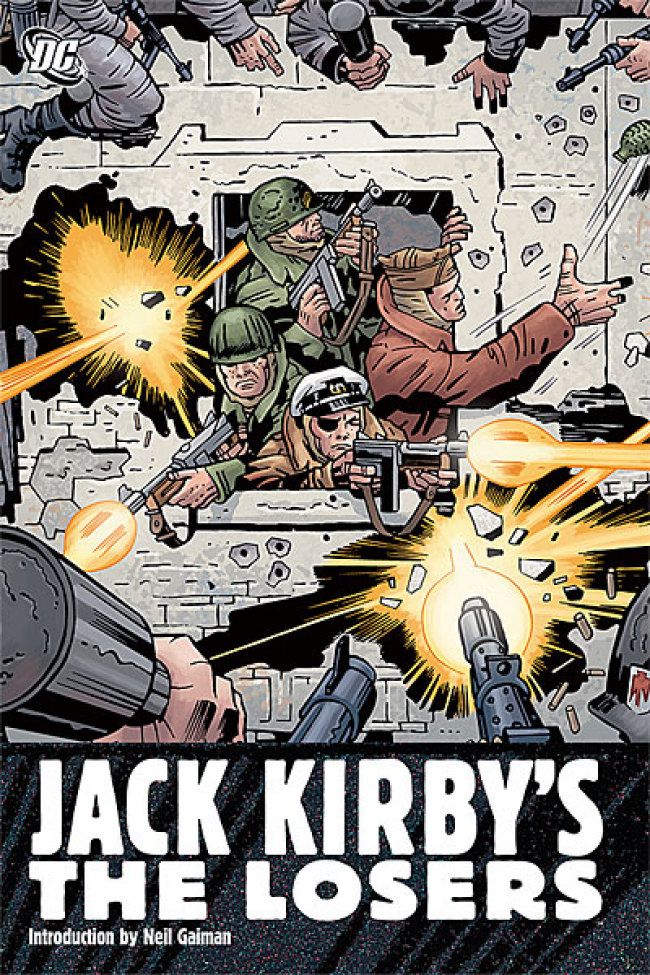Captain Storm, Johnny Cloud, Gunner, and Sarge. If you're like me, you know them from...
That time they died in "Crisis on Infinite Earths"? Their appearance in the opening section of "DC: The New Frontier"?
And that's probably about it.
A Robert Kanigher creation from a 1970 issue of "Our Fighting Forces" (well, the characters had appeared in various war comics over the years, but they didn't star in their own series until then), the Losers were a special forces team that served all around the world. Like some kind of WWII version of the Village People, they had representatives from each of the branches of the armed forces, and their bad luck always put their fat in the fire. Or so the internet tells me. If I had to go by the contents of "Jack Kirby's The Losers" alone, then I would just think this series was about four generic soldiers and their insane wartime adventures. But because it's Bronze Age Jack Kirby, the insanity is at a glorious peak.
In this hardcover volume, formatted to fit right beside the other recent DC Kirby releases, we get the entire run of Kirby's "The Losers," originally printed in "Our Fighting Forces" #151-162 from the mid-1970s. I haven't read a single issue of Kanigher's incarnation of the team, but I've read plenty of other Kanigher war comics in my day, and I know enough to suspect that this isn't really Kirby's version of "The Losers." This is Kirby's version of a Kirby war comic, and the Losers are just along for the ride.
Take, for example, a sequence in which the Losers disguise themselves as German officers to infiltrate the enemy. Johnny Cloud, a Navajo, has barely any discernible personality in Kirby's stories, but looks Native American at least (filtered through Kirby's unique perspective). Yet Kirby has him putting on a German uniform and nobody seems to notice that he looks pretty damn far from a Deutchlander. Kirby seems to draw the characters distinctively just so we could tell them apart -- Capt. Storm always had his eyepatch, Sarge wore a helmet -- but he doesn't seem interested in actually giving them any kind of personality that matters. They are bad luck heroes, stumbling into trouble and then figuring a way out of it, usually with the help of someone far more interesting.
In his intro, Neil Gaiman writes, "There is a case to be made for the Losers as the last great Jack Kirby comic." And while that's an enormous stretch (since it asks that we ignore "The Eternals," "Black Panther," and "Silver Star," all of which are poptastic Kirby fun), there is something to the notion that, even with its faults, "The Losers" might be seen as one of the great Kirby comics.
How many other Kirby comics feature a vacation that turns into a run-in with Nazis and ends with a guest appearance by General Patton himself? Or a story in which a group of reluctant heroes save Broadway? Or the tragically enormous Panama Fattie? Or Yamashita and his Bushido code? Or "Mile-a-Minute" Jones in his last great foot race against the forces of evil?
Or, in the very best story of the volume, Rodney Rumpkin: Science-Fiction Soldier, who sadly wears a fake futuristic get-up to pilot the "Devastator," a comic book weapon come to life?
These are bizarre and wonderful war stories, and while they're surely far from the Kanigher concept of the team, they are pure Jack Kirby.
Yet I wouldn't go so far as to call the collection "great." In small doses, these Kirby stories have a bombastic charm, but they don't work extraordinarily well in a series about a special forces team. I'd say it's very good Kirby -- and these stories are certainly a vast improvement over the "Sgt. Fury" stories he did with Stan Lee at Marvel -- and very good Kirby is better than most, even when he's inked by D. Bruce Berry, who tends to sap the energy completely out of Kirby's pencils.
Luckily, half of the stories in this volume are inked by Mike Royer -- arguably Kirby's best inker -- and even Berry can't dull the explosive might of Kirby's action sequences. And, no surprise, this book is full of 'em.

